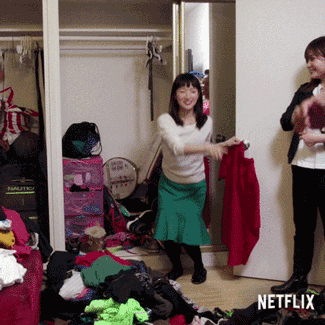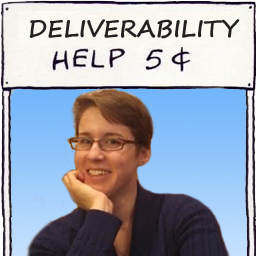Read time: 6 minutes
Thanks for coming in for your regular deliverability checkup! Have you been keeping up the regimen from your last visits? Good, good. Today let’s chat about how clutter can negatively affect your deliverability health, and how you can use the KonMari method to tidy up your email audience.
Marie Kondo’s central insight is that we often need less than we have, that cutting things out can actually enrich our lives. Your email list is no different. Yes, tidying up can be a painful process—whether you’re sorting through the heart-shaped box of macaroni Valentines you made in preschool or cutting down your email audience. But the results are worth it.
We all know this: a smaller but more active email list can mean more opens, actions, and donations than a cluttered, less active audience. For example, the groups in our year-end fundraising analysis who saw their list size drop year-over-year also saw BETTER returns: a 26% improvement in response rate and a 2% improvement in email revenue.
Here’s why it works: Inbox providers like Gmail or Yahoo are working to protect their users by filtering out spam. As spammers have become more sophisticated, so have spam filters. Nowadays, they’re looking for engagement—do the emails you send spark joy in your subscribers? (Marie Kondo describes it as the feeling you get when you hold a puppy. Since inbox providers can’t measure that (yet!), they track metrics like opens, clicks, and how long people spend reading your emails.)
If your list is cluttered up with inactive subscribers, it will weigh down your deliverability (just like those boxes of family photos in the corner of your living room is weighing on your mind). Inbox providers are GOOD at decluttering, so if they see that your emails aren’t engaging with subscribers, they’ll tidy your emails right into the spam box.
Another benefit of a streamlined audience is generating more useful test results. If you are running A/B tests to a file that includes a big chunk of inactive users, it’s much harder to spot a statistically valid difference in results. On the other hand, when your audience is more attentive, they will actually see and react to your tactics—giving you the insights you need to improve your program.
But—we know—it’s hard to let go of subscribers. What if one of them wants to make a donation someday? But listen—you’re never going to wear that cute but itchy sweater Aunt Susan gave you for Christmas six years ago. And that subscriber who hasn’t opened any of the 50 emails you sent them isn’t going to open the 51st. Thank them for their past support, and then say goodbye.

Here’s how to declutter your list, the KonMari way:
1. Figure out what you’re dealing with.
Go on. Take all of your email metrics out of your closet and pile them onto your bed. If you can, divide them into categories by domain (Gmail, Yahoo, Hotmail, and AOL are likely your top four). Look at your open rates—are they lower than previous years? Below benchmarks compared to others in your sector? Look at soft bounce rates—have they gone up over time? Do they often go higher than 2-3%? What about spam complaints—are they higher than 0.1%?
If you answered “yes” to any of those questions, it may be time for a deliverability decluttering.

2. Keep the subscribers who are sparking joy (by opening your emails).
Of all the email metrics that inbox providers track, the easiest one for us to see is open rate. So when it comes to decluttering for deliverability, opens = sparking joy. You only want to keep subscribers on your list if they’re opening your emails. (Important note: there are occasions when someone might open your email but it doesn’t show up in your tracking—for example, if they don’t download images—so in your data work, assume anyone who clicked an email opened it, too!)
Drop records off your target list and into your suppression file if it’s been too long since they’ve opened any of your messages. “Too long” will depend on your list—usually the sweet spot is about 6-9 months of emailing. If you send a high volume of mail, you might find 3 months is plenty of time to give people a chance, or if you only send messages occasionally, you might be able to push out to 12 months (although that’s the absolute limit, and even that is too far for most organizations nowadays).
If you’re not sure what the cut off point for your list is, break it into chunks for a few messages and see how each segment performs. You may be surprised at how few people in your 6-9 month segment respond to or even open your emails!
Say goodbye to all those disengaged subscribers!

3. Be extra-careful with new subscribers.
Someone who’s new to your list should be the MOST excited to get your emails—they have just invited you into their inbox, it’s the honeymoon period. So if they’re not opening, something could be very wrong—maybe they gave you the wrong email address on accident. Maybe they even maliciously and intentionally signed up a spam trap address, to test to see if you’re a bad sender! (It’s awful, but it happens.)
That’s why subscribers who have never opened a message should be viewed with great suspicion. Give new joins 1-3 months to open an email. If they don’t, declutter them right into your suppression file.
4. Be ready to repurpose and re-engage subscribers.
When decluttering, it’s often easier to repurpose something you already have instead of going out and buying something new, like turning an old shoebox into a sock drawer organizer. An email subscriber might fall off your list for a while, but then indicate a readiness to come back by taking an advocacy action they see shared on Facebook. They might even actively sign back up for your list by filling out the newsletter signup form on your homepage.
Make sure your query logic is ready to give those re-engagers another chance: go ahead and email anyone who’s taken action in the past 2-6 weeks (or long enough to ensure they get 2-3 emails), even if they haven’t opened recently.
5. Sort through your precious donors last.
Marie Kondo wants us to wait to tidy our sentimental items last. And when it comes to email audiences, what’s more sentimental than our donors? They loved us… gave us money… it’s understandable that we want to hold on to them and keep emailing all of them, forever.
But “all of them, forever” isn’t the answer for any sentimental collection. It’s not wrong to treasure your donors a little more than the rest of your list, but you do have to cut them off eventually. Email your online donors for up to a year after their last gift (maybe 18 or 24 months, if your data supports it)—but after that, only keep sending messages if they’re still opening. In other words, hold them to the same standards as your non-donors (see #2).
And your offline donors? I’m sorry, but no special treatment. If they give you their email address, hold them to the same standards as other new joins. If they open emails or take action online, they’ll stay subscribed. But if they ignore your emails—if all they’ve done is make a gift offline—they’ve given no indication they want you in their inbox. Leave them off your email list, and keep communicating with them through the offline channels they’ve shown they prefer.
Once you’ve gone through these decluttering steps, your deliverability should feel refreshed and energetic. It may take a little time for spam filters to get used to your new look, but in time, your tidy email audience should be delivering you strong results—fewer messages going to spam, which means more messages going to the inbox, being opened, being clicked, and bringing in actions and donations. And you should feel that spark of joy whenever you look at your new and improved email metrics!*
*And that, my friends, is the last spark joy reference and pun you’ll get out of me. Can’t wait for the next loved/hated trend to riff on next time!




